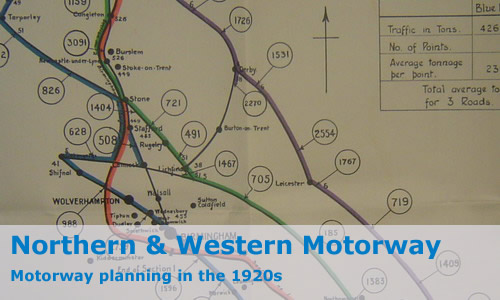Justification of the Motorway
Of course, with no motorways in the country, and with hardly any across the world, the Northern and Western Motorway Company needed to convince five groups of people as to the benefits of the motorway:
- The public at large
- The embryonic road haulage industry
- Local authorities along the route
- Investors in the company
- The Government
Of those people, the latter two were absolutely critical. Without sufficient investment, the company stood no change of constructing the motorway; whilst opposition by the Government would make it almost impossible to create the legal framework for the motorway. Opposition of any of the former three groups would affect the reactions of the other two, whilst their support would act as a positive force as far as the Company was concerned.
The Company used multiple justifications as to why the motorway should be built. Firstly, they pointed out that the roads of the time were designed for horse-drawn traffic, yet in November 1922, there were more than 1,360,000 licences for vehicular traffic; whilst the number of horse-drawn vehicles had dropped from nearly 270,000 to around 180,000 during a single year. At the same time, the Company showed that the amount of goods traffic travelling by road had also increased, with the roads in 1922 carrying over 11 times the weight of goods than in 1913. As they claimed that it was prohibitively expensive to expand the railways any further, then it would be more effective to expand the road capacity.
The Company also suggested that a return to the Turnpike system, where travellers paid a toll to a private company who maintained the roads which lead to improvements on the roads, would be a good idea. They suggested that although the railways had killed off the original turnpike system, that the circle was now complete and that new roads, supported by a toll, were once again the way forward. They also pointed out that local authorities were being forced to pay for the maintenance of the existing roadways, which were considered to be unsuitable for heavier and heavier road-going vehicles.
Finally, it was also suggested that the construction of the motorway could act as unemployment relief scheme of the kind that would later in the decade assist in the construction of several new ordinary roads.
The road haulage industry, it was suggested, would be in favour of the new motorway due to its economic advantages, due to time savings. The motorway would clearly avoid town centres, and would be constructed as to allow higher speeds than those possible on the ordinary roads of the day. The Company also suggested that there would be savings in the maintainence of the vehicles, as well as better fuel economy. These advantages would allow companies to both make more deliveries, and to deliver over a wider area.
For the public at large, however, the Company emphasised the removal of goods traffic from local roads as being the major benefit, though it is clear from their literature that
The private motorist travelling will be attracted to the Motorway when he wishes to undergo long-distance journeys. For the business motorists also, it will provide a ready means of access to the various industrial centres, free of all restrictions.
It is clear that the Company were really interested in commercial traffic, and ordinary motorists were very much an afterthought.

